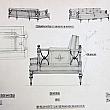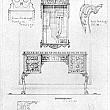
Frank C. Lee Interprets American Colonial
Interpreting traditional furniture and adapting it to commercial purposes, correctly, entails more than a cursory knowledge of the fundamentals of furniture design. Where to go for ideas a how to recognize them when found is an art developed only through years of association with furniture history. As an aid to the furtherance of good furniture design and knowledge of what make it so, Fine Furniture inaugurates this department, conducted by designers, successful commercially and having a background that entitles them to discuss authoritatively, a subject of interest to the entire furniture industry.
Where do designers get their ideas? A natural, frequent and in some cases, embarrassing, question. Frank C. Lee, in this month’s Sketch Book, demonstrates how a commercial piece is developed.
.jpg) Having in mind an adaptation of American Colonial, based on Georgian influence, he thumbed through a copy of Wallace Nutting’s Furniture Treasury. Coming upon a mirror that struck his fancy, he saw possibilities of developing a commercial suite. The sketch in the left hand corner of the design is a copy from the book—a mirror produced about 1775, with wire wheat ears above the urn, which was a feature of Hepplewhite’s period and incorporating beaded decoration. Now for the transition to commercialism.
Having in mind an adaptation of American Colonial, based on Georgian influence, he thumbed through a copy of Wallace Nutting’s Furniture Treasury. Coming upon a mirror that struck his fancy, he saw possibilities of developing a commercial suite. The sketch in the left hand corner of the design is a copy from the book—a mirror produced about 1775, with wire wheat ears above the urn, which was a feature of Hepplewhite’s period and incorporating beaded decoration. Now for the transition to commercialism.
In the first place the proportion of the pediment on the original mirror is out of scale for current use. It must be reduced in height and altered in silhouette. The expensive wire wheat ears are replaced with wood carving, as is the gold bead on the face. So much for the mirror.
The cariole leg in the right hand corner of the design page is a beautiful specimen of Chippendale carving, taken from another of Nutting’s books. Examination of the exquisite detail on the knee and comparison with the leg on the finished sketch illustrates the modification necessary in reducing genuine motifs to modern production methods and current price trends. The slightly rounded corner is also a deviation from honest Chippendale in favor of commercialism. The acute angle of the purer style is prohibited by production costs. The characteristic claw and ball foot is taken from a Philadelphia low boy, also in Nutting’s Vol. III.
An interesting bit of lore concerning the bracket is that such an addition enhanced the piece it adorned two and often three times its value.
Thus we have assembled several characteristic motifs, indirectly related, and consolidated them into a harmonious single unit. The style is American Colonial, Georgian influence, the wood mahogany and the price—possible in the medium price bracket.
Excerpted from Fine Furniture, Vol. 1, May 1936, page 26

 facebook
facebook

